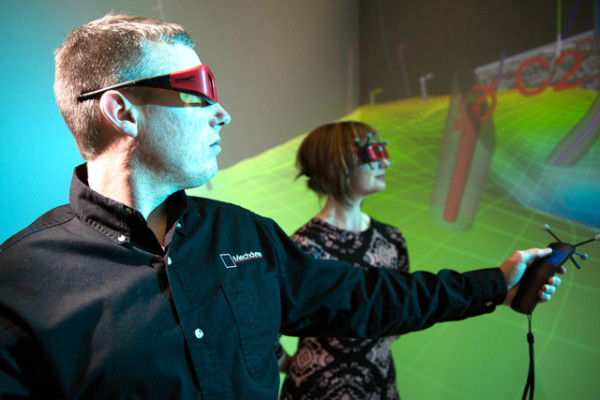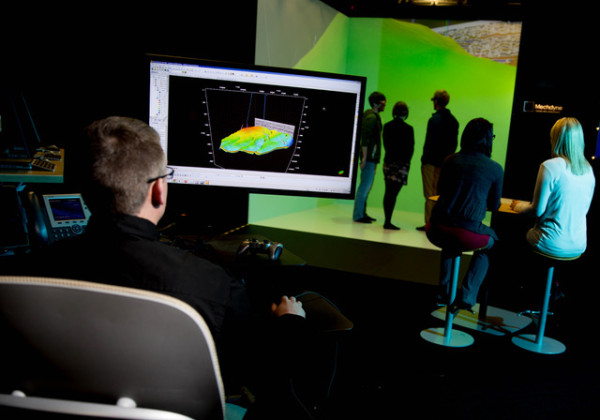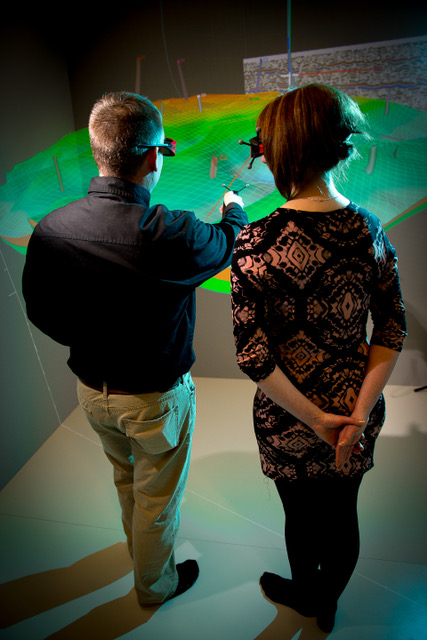Seeing is Believing: Visualization Technologies for Better Collaboration


The Shell 3-D Visualization Center at the University of Wyoming was established as a computational energy research facility for students, professors, and researchers to analyze data related to mining, and oil and gas. Designed and integrated by Mechdyne Corp., a 3D visualization and virtual reality technology developer headquartered in Marshalltown, Iowa, the lab comprises a four-sided CAVE, a video wall, and three portable “mini-caves.” With these systems, users may literally walk in and immerse themselves in their data to collaborate on such topics as geological analysis, the feasibility of specific mining and/or oil drilling locations, and potential oil and gas opportunities. The Visualization Center also offers cross-departmental collaboration opportunities for those working in architecture and civil engineering, medical sciences, molecular biology, and STEM (science, technology, engineering, and mathematics).
“The researcher can see, on a flat screen, one thing, but when they can walk around the data and see more spaces, or a molecule and how it’s folded in a different way that they’re able to better see the interactions, they’re able to make connections that benefit their research,” Diana Hulme, deputy director for research, School of Energy Resources at the University of Wyoming, has said of the facility.
While the University of Wyoming’s collaborative facility is designed for users that are all in one place, Mechdyne’s software-based TGX solution addresses the need for collaboration among far-flung team members that require precise visual reproduction. “Think of it as Skype on steroids—essentially it’s a desktop sharing tool, but it is designed for really high resolution and really good color fidelity,” explained Mike Pedersen, senior staff engineer at Mechdyne. “[With it,] we can take two 4K monitors off a single PC and we can send those off to a remote location, and [users] can look at [the data] in real time.”

Pedersen notes that this solution is also finding success in the oil and gas industry, where experts in North America and Europe are communicating with team members located on drilling sites in developing countries, or offshore. “Using a product like TGX allows them to collaborate very well—they can look at the seismic data, they can do their well planning, and they can do the geo-science stuff that they need to do in order to be successful in what they’re trying to accomplish.” He adds that the automotive, medical, and consumer packaged goods markets are also employing this technology for remote sharing and collaboration on product and packaging development, or for education and research.
At the University of Warwick in England, the goal is to provide students and faculty with a BYOD solution that enables them to share content wirelessly to displays in the AV-equipped rooms in its Oculus building. To achieve this, the institution is using Solstice Pods by Mersive Technologies Inc., a collaboration solutions developer headquartered in Denver, Colo. The Solstice Multi-Room feature allows for connection between separate rooms, and several Solstice Pods in one space can share content, enabling individual groups to share with the rest of their classmates. “It does not just replace the cable that tethers a presenter to the front of the room—it acts as a true communication platform, accessible by any member of the classroom, from any device they brought with them,” Jonathan Owen, the university’s IT services owner, has said of the technology.

One issue that tech managers continue to face in deploying visualization technologies for collaboration—especially when it involves remote locations—is bandwidth. Getting data from Point A to Point B may not be too much of a problem when both locations are office buildings that have solid bandwidth access, but moving data to remote sites in areas where the infrastructure is unreliable is another matter. Pedersen hails Mechdyne’s TGX as particularly strong in bandwidth efficiency, however even he concedes that at a certain point tech managers must make compromises. “If you don’t have the required bandwidth, you’re going to have to do some type of compression, you’re going to have to do some type of reduction of the refresh rate,” he said. “Something at some point has to give—a video at a certain refresh rate and resolution takes so much bandwidth, and if you don’t have it, then you have to do something to reduce that.” This is when it’s time to ask: what are we willing to give up? Refresh rate for better resolution? Resolution over refresh rate? Color fidelity? All of this depends on what the end goal is: if on-site managers in the oil and gas sector need to see detail, perhaps they can live with a slower refresh rate. On the other hand, aerospace pilots conducting simulations might be able to live with less accurate color and resolution, but they are probably going to need fast refresh rates.
Pedersen also points out that tech managers must assess whether or not the software packages they’re considering are up to the task when it comes to supporting the required resolution, color fidelity, and refresh rates for advanced visualization. This becomes increasingly important for applications involving stereoscopic imagery for 3D modeling. “That lends itself to another list of challenges as far as what type of software even achieves stereoscopic collaboration,” he said. “It’s a very, very, very short list.”
A daily selection of features, industry news, and analysis for AV/IT professionals. Sign up below.
One of the issues that many organizations face with collaboration tech deployment is that while it may be available, it’s not being put to good use. Utelogy Corp., a software-defined platform developer headquartered in Irvine, Calif., aims to help tech managers resolve this with its solution, which provides insight into systems usage. “For us, it is about data and helping tech managers understand these usage trends so they can make purchasing decisions based on what their users are actually doing,” explained William Tinnel, senior vice president and chief commercial officer at the company. “We can compare things like 323 and SIP usage versus the Zooms and the Sparks of the world. We can see that while it looks like videoconferencing trends may be decreasing in an organization, when you compare it to the other types of technology being used for collaboration, in fact it’s increasing.” He argues that this leads to better decision-making on things like real estate: perhaps the analytics suggest a need for fewer eight to 10-person conference rooms and more huddle spaces. “We can make smarter room size decisions based on these types of collaboration trends that are actually taking place inside the organization.”

This type of analysis also enables tech managers to gain a better grasp of what users actually need, which in turn reveals how the tech department can improve upon training, and therefore usage trends … and therefore, ROI. “I think we need to do a better job of educating and helping users understand [why they need to use collaboration technology,]” Tinnel said. “If the users understood that they’re going to be required to come into the office more because collaboration isn’t taking place at a very efficient level, then they may be more apt to use the technology—and we’re seeing more users having to come in because collaboration is not taking place.” Armed with this information, tech managers can begin to examine whether or not they’ve deployed the right technology, or if low usage statistics are a result of poor training. “When we see a certain business unit, or a certain sector of an organization not adopting the technology, that gives tech managers the tools to say: here is where we need to educate because adoption is low, therefore our ROI on this technology is low. If we can spend some time educating, we can get that usage to where it needs to be, get the full value out of the technology, and ultimately make our users more efficient.”
Carolyn Heinze is a regular AV Technology contributor.
INFO
Mechdyne Corp.
www.mechdyne.com
Mersive Technologies Inc.
www.mersive.com
Oblong Industries
www.oblong.com
Utelogy Corp.
www.utelogy.com
Carolyn Heinze has covered everything from AV/IT and business to cowboys and cowgirls ... and the horses they love. She was the Paris contributing editor for the pan-European site Running in Heels, providing news and views on fashion, culture, and the arts for her column, “France in Your Pants.” She has also contributed critiques of foreign cinema and French politics for the politico-literary site, The New Vulgate.
